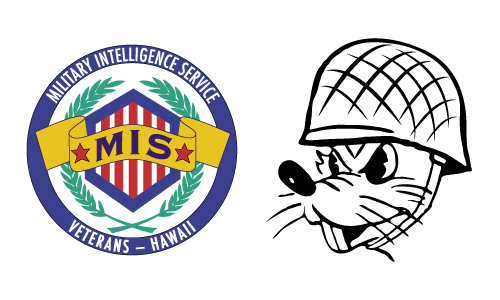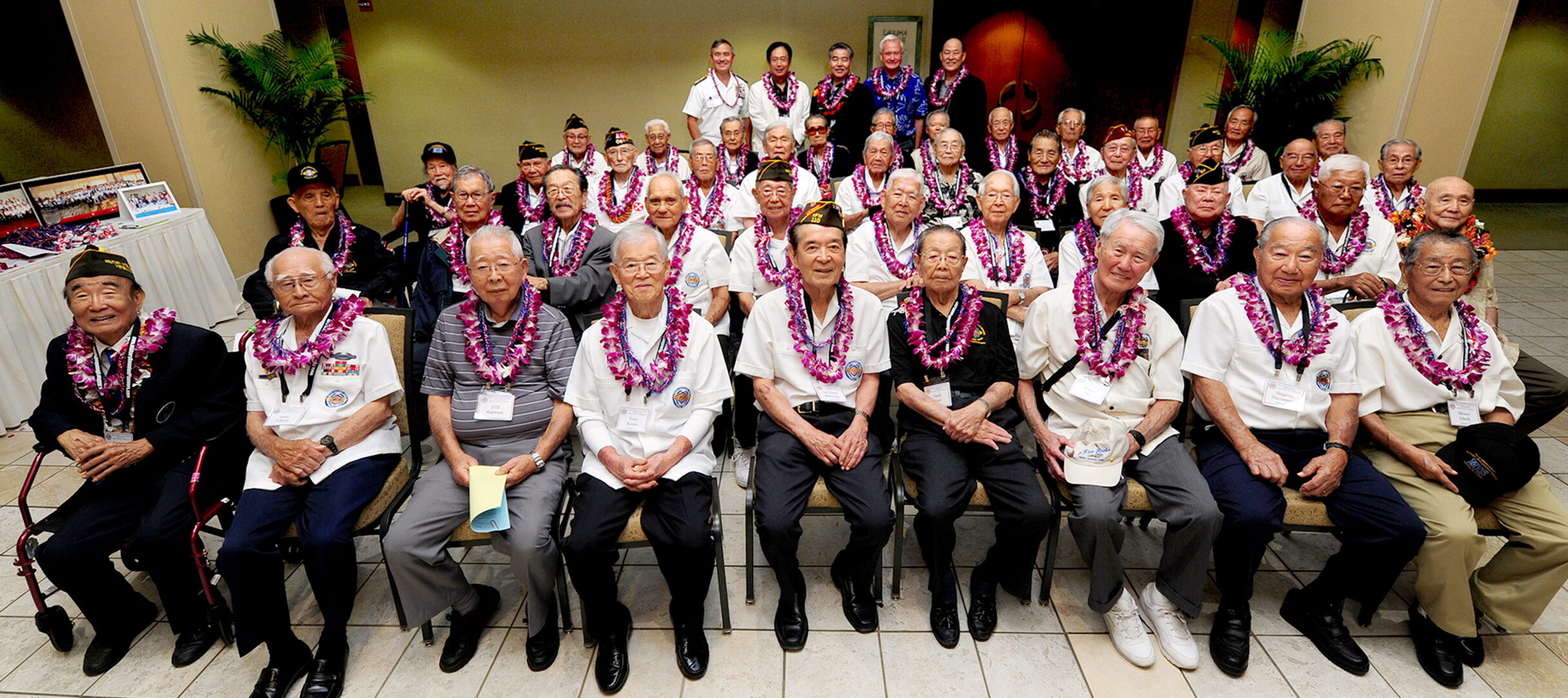Above: Military Intelligence Service veterans from across Hawai‘i and the Mainland joined to celebrate the 70th anniversary of the MIS, an event held in March 2015 at the Hale Koa Hotel. The reunion was held in conjunction with the opening of an MIS exhibit at the Hawai‘i Army Museum in Waikiki. Keynote speaker was Admiral Harry B. Harris, Jr., head of the Pacific Command (back row, far left). Photo by Terrance Takaki.
The Military Intelligence Service Veterans Education Society of Hawai‘i is a non-profit organization of past and present members of the United States armed forces and their descendants.
The club’s mission is to preserve and perpetuate the achievements of the World War II nisei veterans of military intelligence through public education programs in Hawai‘i and elsewhere, participate in community service that honors MIS and military intelligence veterans, and create partnerships with other organizations and institutions in furtherance of the club’s goals.
Officers and Board of Directors
OFFICERS
President: Karen Kikukawa
Vice President: Vacant
Treasurer: Sherman Takao
Secretary: Vacant
DIRECTORS
Lawrence Enomoto
Keith Matsumoto
Mark Matsunaga
Carolyn Morinishi
Wilbert Toda
Our History
The Military Intelligence Service Veterans of Hawai‘i was founded in June 1946 by a handful of recently discharged Japanese American soldiers.
The veterans often got together to socialize, and they knew other veterans who were organizing themselves and wanted to stay in touch. They decided to form a club to hold patriotic and social activities in coordination with Mainland clubs.
A meeting was called at the Nuʻuanu YMCA in June 1946, attended by seven MIS veterans. Masaji Marumoto, the first Asian American graduate of Harvard Law School and a future state Supreme Court justice, was chosen to be the first president. The club was initially known as the Military Intelligence Service Language Associates. The name was later changed to the Military Intelligence Service Veterans. The club had two purposes: participate in or sponsor patriotic activities and provide social and recreational activities for its members.
A 1962 club booklet said, “The aims of the organization are: (1) to maintain fellowship among the MIS veterans and their families and to provide mutual assistance and (2) to participate in community service.”
The booklet went on to say the club’s objectives also included “to uphold and defend the United States of America and maintain representative government, to preserve and strengthen the democratic principles for which it stands, to promote goodwill and better understanding among all races and creeds, to sponsor and promote activities and programs by and among our members and general public in order to attain the aforementioned objectives, and advance the interests of this organization in every way consistent with public good and to do such other things as properly come within the scope of this or similar organizations.”
Club membership eventually reached several hundred. That was, however, far short of the 3,000 or more MIS veterans believed to be in Hawai‘i at the time or the approximately 6,000 Americans of Japanese ancestry who served in military intelligence in World War II.
While the club was formed by Americans of Japanese ancestry, membership was not limited to that ethnic group, and some veterans of other ancestries joined. In addition, the club also invited veterans who served after World War II to become members.
The MIS Veterans of Hawai‘i has drawn its membership primarily from veterans living on Oʻahu. Other MIS veterans organized clubs in Northern and Southern California, the Pacific Northwest, Rocky Mountain area, and Neighbor Islands. But as the veterans have aged, some of these organizations have closed their doors in recent years.
Few Americans outside of these clubs knew what the military intelligence veterans had accomplished during the war until the federal government began declassifying their records in the early 1970s. That opened the door for publication of books such as Joseph Harrington’s Yankee Samurai in 1979 and Richard Oguro’s Sempai Gumi in 1981.
The MIS Veterans of Hawai‘i lived up to its patriotic purpose, providing MIS representation at World War II commemorations and military ceremonies. MIS veteran Kenzo Kanemoto began a Memorial Day tradition of placing flowers at the graves of fallen MIS members at the National Memorial Cemetery of the Pacific at Punchbowl.
In addition to support for charities, the club provided ample opportunities for fellowship with an annual Christmas party, bonenkai (year-end party) and shinnenkai (installation banquet/new year party) that continue to this day. Golf tournaments and group tours to Japan and Las Vegas proved popular over the years.
The club newsletter was a unifying, informative force over the years. It was produced by talented and selfless volunteers, including some veterans’ wives. James Tanabe, an MIS veteran of the Korean War, served as newsletter editor for over a decade and worked with volunteers from the club’s ranks to complete interviews of scores of veterans and videotape them for posterity. He and Ted Tsukiyama, Dr. Yoshinobu Oshiro, and other members collaborated on articles and books.
Over the years the MIS Veterans of Hawai‘i participated as a full partner in numerous gatherings and activities for Americans of Japanese ancestry who served in World War II, here and on the Mainland: the Rev. Yoshiaki Fujitani represented the MIS when he offered a prayer as part of the official ceremony at the Punchbowl ceremonies, with President Bill Clinton in attendance, marking the 50th anniversary of the end of the war. Club members volunteered to help spruce up the Battleship Missouri and served as docents and tour guides. VFW Post 110 was established by the Hawai‘i MIS veterans.
The club supported the Oʻahu AJA Veterans Council’s effort to create the Brothers in Valor Memorial in Waikiki, which honors the four principal AJA units of World War II. The club has participated in the council’s annual Joint Memorial Service at Punchbowl, which began in 2006.
MIS veterans were front and center for the Congressional Gold Medal award ceremonies in Washington, D.C., and Honolulu that honored the service to country of the AJA veterans.
In June 2000, thanks to then-U.S. Senator Daniel Akaka and many others, the Army awarded a Presidential Unit Citation to the Japanese Americans who served in the MIS during World War II. The MIS Veterans of Hawai‘i was an integral part of the effort to earn that recognition and the subsequent celebration.
In the mid-1990s, the club established itself as an eleemosynary organization, in hopes of being able to receive charitable gifts and perhaps establish a scholarship for Asia-Pacific studies. The idea came to fruition in 2003 when member Dr. Glenn Masunaga arranged for the Makiki Japanese Language School to donate money to the club, which then added to the fund, to endow a scholarship fund for University of Hawai‘i students of Japanese language and culture.
Thanks to support from then U.S. Senators Akaka and Daniel Inouye, Nisei Linguists: Japanese Americans in the Military Intelligence Service during World War II, a comprehensive history by Army historian James McNaughton, was published in 2006. That was part of a wave of renewed interest in the MIS story, with the publication of veterans’ memoirs and several movies, including at least three Japanese productions.
The club supported efforts to tell and preserve the story of the AJA veterans including the Legacy of Valor display at Central Pacific Bank; the Japanese American National Museum in Los Angeles; National Archives research by the NARA Project; the National Japanese American Historical Society’s preservation of Building 640 at the Presidio of San Francisco, and others. Individual club members have contributed artifacts and documents to these and other projects. The MIS Veterans of Hawai‘i has also provided its share of support to recent efforts to develop a Nisei Veterans Legacy Center on Oʻahu.
The club established a website in 2015—www.misveteranshawaii.com. Along with the newsletter, the website is used to inform current members, encourage new membership, and preserve the legacy of the MIS.
Past Presidents of the MIS Veterans of Hawai‘i
Masaji Marumoto, 1946-1947
Warren Gima, 1948
Yoshio Hanao, 1949
George Hironaka, 1950
Mark Murakami, 1951
Toma Tasaki, 1952
Charles Kimura, 1953
Kenji Goto, 1954
Dan Nishimura, 1955
Robert Kimura, 1956
James Shigeta, 1957
Norman Kikuta, 1958
Arthur Komori, 1959
Christian Nakama, 1960
James Shigeta, 1961-1962
Yoshimi Hayashi, 1963
Harold Otani, 1964-1965
Sohei Yamate, 1966-1967
George Ariyoshi, 1968-1969
Gilbert Nagata, 1970
Mitsuo Mansho, 1971-1972
James Shigeta, 1973
Frank Takao, 1974-1976
Russell Kono, 1977-1978
Minoru Shinoda, 1979-1980
Wallace Amioka, 1981-1982
Steve Ohira, 1983-1984
Andrew Sato, 1985-1986
Donald Iwai, 1987-1988
Sam Isokane, 1989-1990
Koon Hin Choy, 1991-1992
George Takabayashi, 1993-1994
Henry Furuya, 1995-1996
Howard Furumoto, 1997-1998
Iwao Yokooji, 1999-2000
Dan Takehara, 2001
Francis Sogi, 2002
Frank Takao, 2003
Andrew Sato, 2004
Frank Takao, 2005-2006
Glenn Masunaga, 2007-2008
Edgar Hamasu, 2009-2011
Glen Arakaki, 2012
George Arine, 2013
Lawrence Enomoto, 2014-2016 (June)
George Arine, 2016 (June)-2018 (February)
Lawrence Enomoto, 2018 (February)-2020 (January)
Shinye Gima, 2020-2022
Lawrence Enomoto, 2022-2023 (January)
Karen Kikukawa, 2023 (January)-Present

